How to Refine a Stock Deck: Pioneer Mice
10/10/2024
At this point, I assume most people see me as a combo player and brewer in constructed. Many of the decks I've registered at RCs and PTs so far have been combo brews in one way or another: RataBlade, Spelunking, Creativity, Slogurk, Nadu. And I admit, I am quite partial to the play patterns of combo decks, and I do really enjoy the process of brewing a deck entirely from scratch.
However, despite my proclivities, I'm not completely averse to playing "stock" decks! You could certainly argue that the Nadu deck Sanctum registered for the most recent PT was pretty close to a popular stock deck and not as much of a brew - we did do a lot of work on improving it, but ultimately didn't end up too far from everyone else.
And in fact, one of my first experiences with success in competitive Magic was with a deeply stock deck! I won VML season 8 playing almost purely Grixis Fable Midrange in Standard, which was by far the most popular and consensus best deck at the time.
All of this is to say, while I often think there's plenty of room to find brews that are better than anything already known, I do recognize that there are generally reasons why popular decks are popular: they almost always have some baseline of power and merit.
So, while I did in fact spend quite a lot of time during Pioneer testing season trying to make weird brews and old ideas work, my top two choices for RC DC were, ultimately, extremely stock: Phoenix, and Rakdos Mice.
Of those two, I do think that Phoenix was the overall stronger choice in the end, and would highly recommend it - specifically builds with
Artist's Talent. However, I stopped my Pioneer testing to focus on Worlds testing roughly two weeks before the event, and at that point I was not aware of just how good Artist's Talent was. And as such, I basically locked myself on Rakdos Mice at that point.And the deck we had was in fact quite good! I'm quite happy with it as my deck choice, and I think it was the second best choice behind Phoenix (and perhaps Selesnya Company in hindsight, though I am very unsure on that point). I think we on Sanctum did a very good job of greatly improving the deck, and throughout the weekend I felt consistently extremely rewarded by the choices we made.
So, today I'm going to lay out both our process, and our conclusions. I'll talk about the changes we made to the deck - but more importantly, why we made those changes, and how we arrived at those changes.
Part 1: Taking Stock
This deck first started catching my attention when it was gaining popularity online. It looked somewhat gimmicky of course, especially with the plan to fling creatures with
Callous Sell-Sword. But after seeing others play with the deck and playing a couple of games myself, it became clear that it was legitimately quite strong.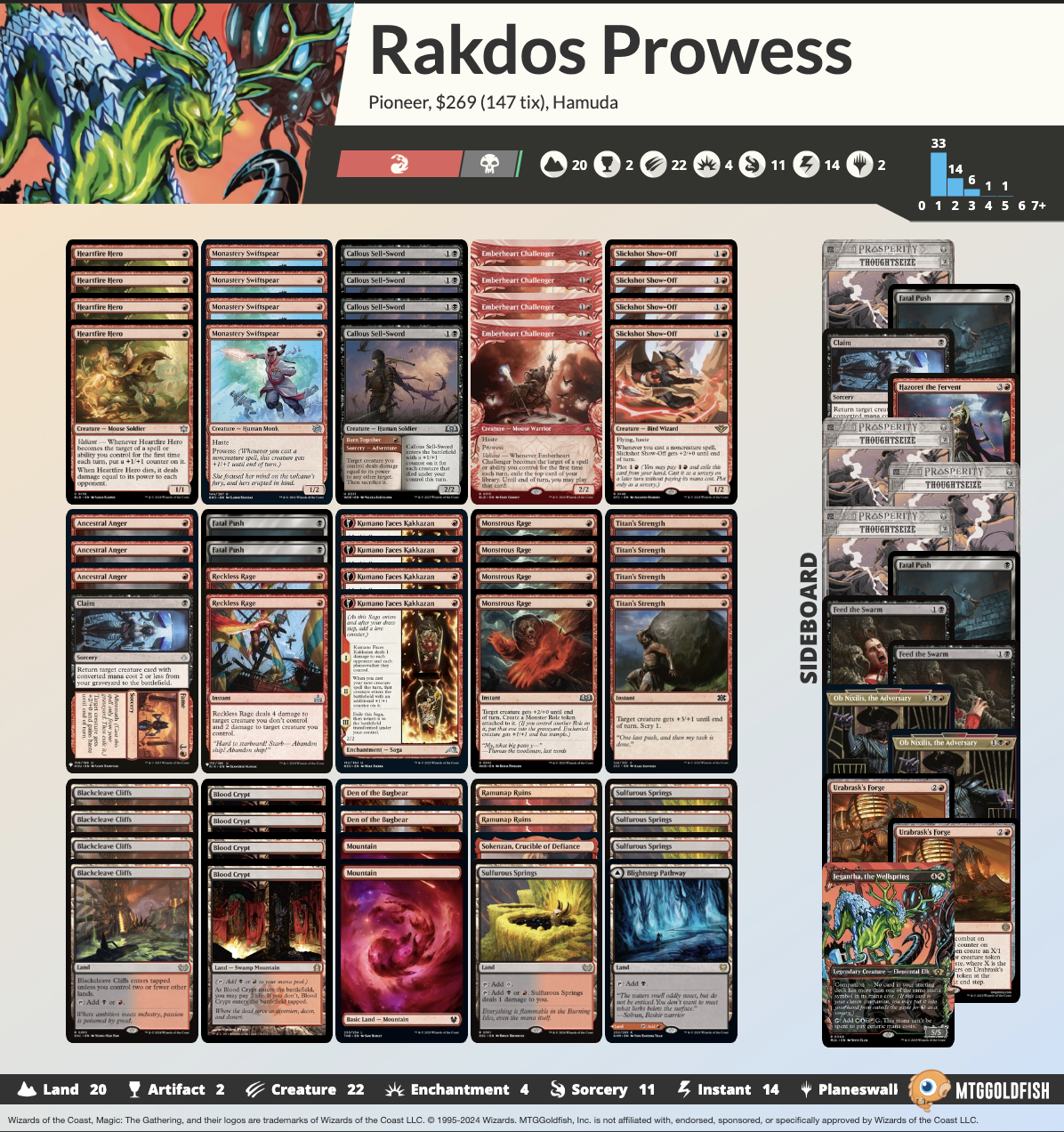
a stock list from Hamuda, a couple days before the event
However, while the stock Rakdos lists did seem quite powerful, they were very much not without problems. Having a strong proactive plan was quite nice for being able to win games, but the deck was also quite exploitable in several other ways.
A Prepared Metagame
I distinctly remember starting to get really interested in the deck about 3-4 weeks before the RC. But at that time, as the deck had been exploding into popularity online, it had also started to garner lots of hate.
Phoenix lists had started to play 8 1-mana removal spells main, and more in the sideboard. Control decks had also started to really increase in popularity, especially ones that tried to attack Rakdos with lots of cheap removal and a bit of splash damage from
High Noon.Overall, the world seemed to have gained due respect for Rakdos, and adjusting both card composition and deck choice in order to attack it. And in the face of this, the deck really started to show its weaknesses.
Specifically, the most effective strategy to beat Rakdos seemed to be simply holding up cheap instant speed removal in order to blank your pump spells and flings. Add to that an eventual transition into lategame haymakers or blockers like
Ledger Shredder to turn the corner, and suddenly many decks could easily manage the aggression that Rakdos was putting up.The Perils of Fame

for the longest time, my name for this deck was simply 'Famous'
Another metagame development I want to highlight specifically is that decks simply started playing
more and more exile removal. This was partially to fight against Heartfire Hero, but it also had the effect of obsoleting Claim // Fame.Before these metagame developments and before I actually started testing the deck, I was actually extremely high on Claim // Fame! To me, it seemed like one of the best ways to "cheat" the normal dynamic of prowess decks. Namely: the card represents two spells that trigger prowess (one of which even triggers valiant!), while also functioning as a creature itself! My theory was that this should help alleviate some of the problems inherent to playing a fundamentally A+B deck (creatures+spells) with little smoothing.
But unfortunately, as the stock of exile removal increased drastically, the stock of Claim // Fame similarly fell.
Part 2: The Cutting Room Floor
So, we've identified the problem. Our prowess deck has some vulnerable holes, specifically surrounding how reliant it is on pump spells. It has a lot of explosivity from those pump spells, but they also carry a lot of risk. So, how can we mitigate that risk?
As always, the answer is to iterate, over and over again. Come up with hypotheses and test them! Try new things, throw stuff at the wall, and see what sticks. Don't be afraid to build and play what might be bad decks - the whole point of testing is to learn, not to win. If you don't test things that might be bad, you'll probably never find the diamonds in the rough.
But I will say, we sure had a lot of rough.
Hypothesis #1: "Titan's Strength Seems Kinda Bad"
My first instinct with this deck was to cut the card
Titan's Strength. And I think that's pretty understandable - the card looks somewhat out of place among a sea of proven strong red aggressive cards. Are we really so hungry for combat tricks that we want to play a card that's so much worse than Monstrous Rage? It doesn't even give trample!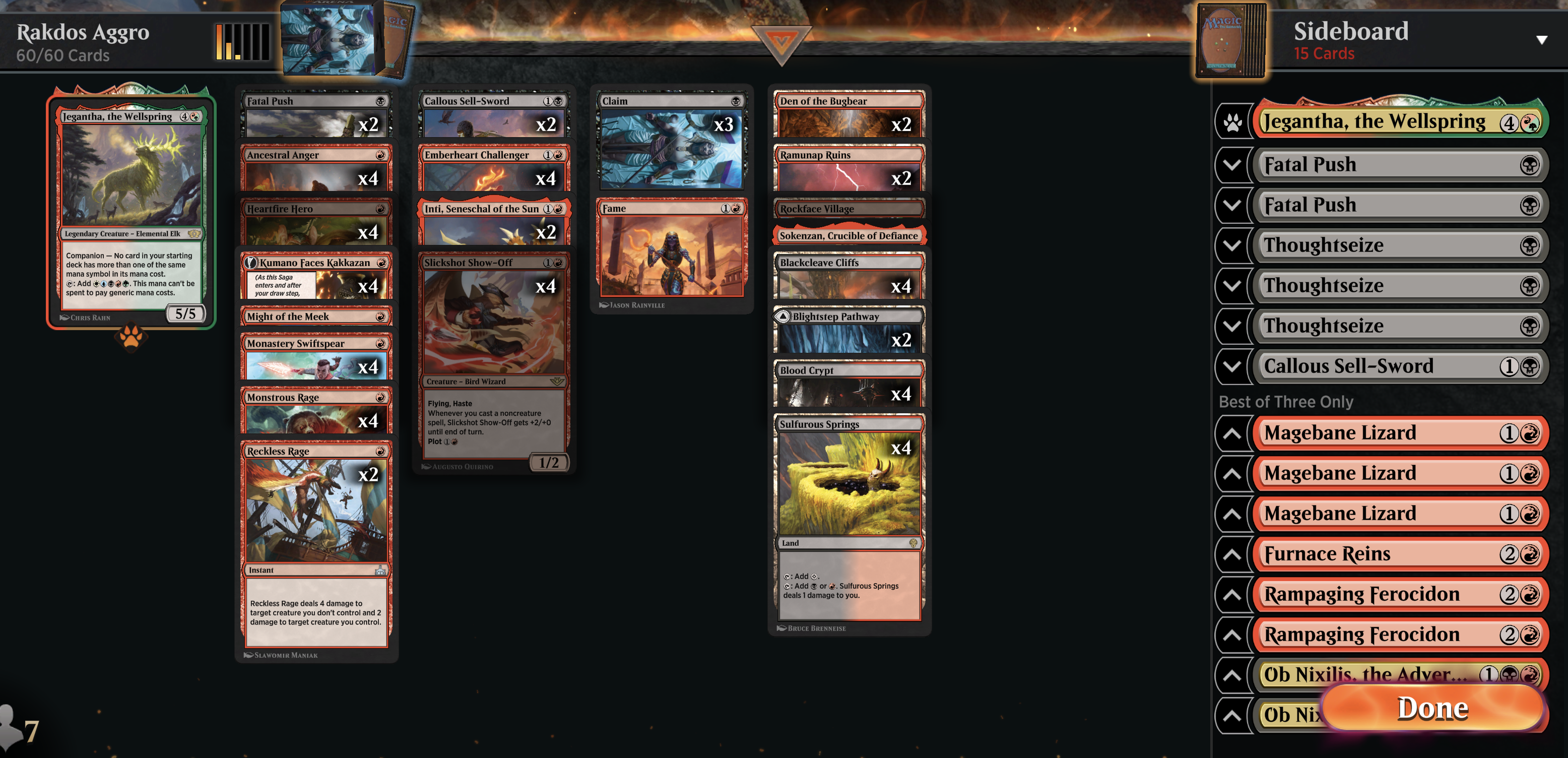
the lack of a basic is a testing thing - i wanted to test which of ramunap or den felt better, and i wanted to draw them both more, so i just played without a basic in internal testing vs non-field-of-ruin decks to generate more data
So, this was the initial build I was trying out. I played a bunch on ladder and in internal testing. And certainly, it was a small bit more resilient than the stock builds, what with copies of
Inti and more interaction. In fact, the extra interaction in general seemed like one of the biggest improvements, specifically as great tools in the mirror and against Ledger Shredder out of Phoenix!But it seemed that the deck in fact did kind of rely on the +3 power pump spells for its explosiveness. This version may have been a bit more resilient - but ultimately that resiliency came at too high of a price in how much explosiveness it gave up. As we joked a lot: we "broke" the deck, just in the bad way. And so, we went back to the drawing board.
Hypothesis #2: "I Hate Slickshot Show-Off"
Okay, so maybe we need the Titan's Strengths for explosivity. But do we really need this
Slickshot Show-Off card? It's another card that just feels so clunky sometimes, as it plays so poorly into opposing removal. It needs you to cast spells to do anything of meaning, and casting spells proactively is a great way to open yourself up to blowouts, which is exactly the dynamic decks are trying to exploit.So, next up is trying to cut the card entirely. What if we went lower to the ground with more 1s? Then we could maybe pressure with pump spells both more efficiently, and perhaps earlier than opponents are prepared for!
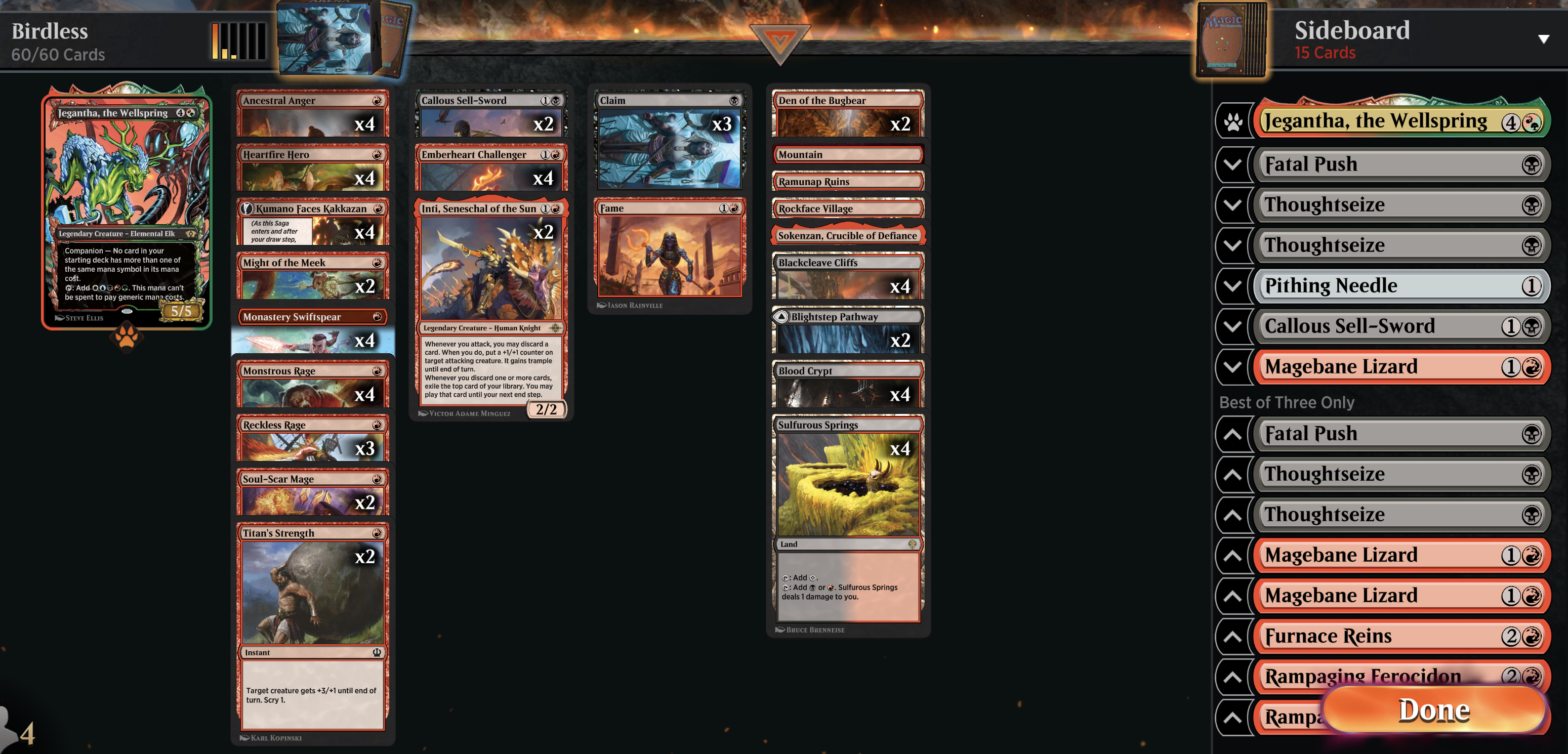
...Unfortunately, as it turns out
Soul-Scar Mage is a pretty mediocre card, and in reality the "try to go even lower" plan didn't actually end up lining up well into anything. And on top of that all of that, like with the +3 power combat tricks, Slickshot just felt somewhat important to speed. Again, we broke the deck (derogatory).Hypothesis #3: "Targeted Cantrips Have Costs"
Okay but actually, let's revisit that idea about Slickshot being bad. The resulting list didn't pan out, but I still thought the theory was somewhat sound - I didn't like how Slickshot asked you to commit your spells proactively. Opponents were trying to attack the deck by being maximally reactive to punish us for casting pump spells proactively, so it made a lot of sense to me to try to respond in kind by limiting the amount we wanted those play-patterns.
As such, I then caught onto one of the first key realizations that really started to feel like progress: targeted cantrip pump spells have icky play-patterns.
Now, on one hand this is pretty obvious. After all, it feels really bad when your opponent responds to your cantrip by removing the target and denying you the card to boot! But specifically with this realization came the question: can we minimize this deck's reliance on targeted cantrip pump spells?
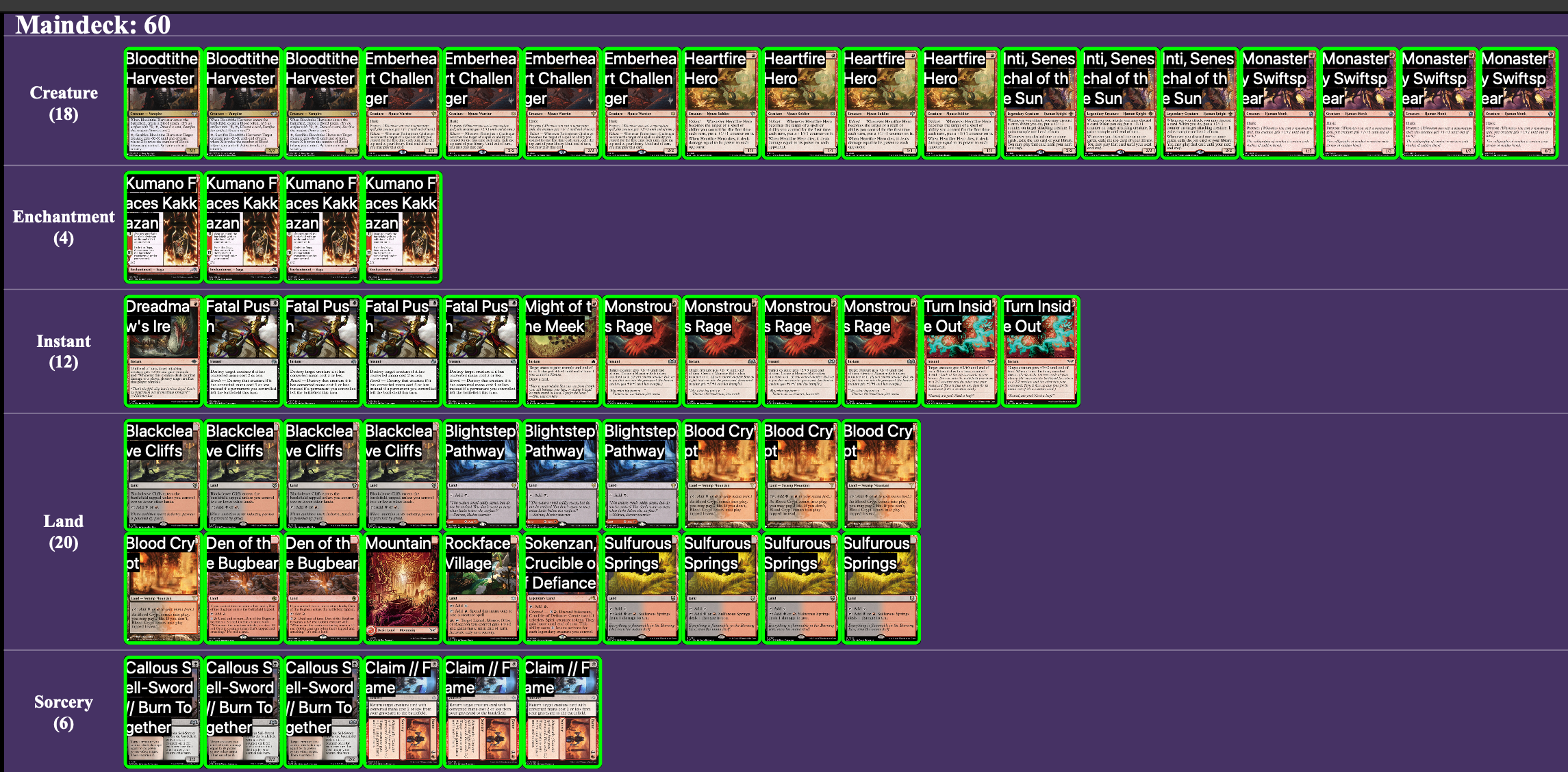
mocked up on Cockatrice bc this was before Turn Inside Out officially released
This list, then, was the prelimary result of trying to go down this direction. The idea is that I want all of my cards to be more impactful overall, rather than trying to get incremental advantage from
Might of the Meek or Ancestral Anger.As such, you can see that I've started moving more in a midrangey direction! I'm still keeping in the +3 pump spells and flings as somewhat of an explosive "combo" plan, but at the same time attempting to use more midrange threats like Inti and
Bloodtithe Harvester to filter towards that "combo" plan. And hopefully in the meantime the lowered focus on prowess means that I can just attack with creatures that are baseline 3 power, instead of relying on casting spells proactively.This was also the point in testing where we were starting to realize that Claim // Fame could not keep up its performance in the developing metagame - but another of my theories with this iteration was that the 6 discard outlet creatures might help with that too, providing ways to fuel the Claims!
Unfortunately, the Bloodtithe Inti plan just ended up being a bit too fair - especially Bloodtithe. Explosive draws just didn't line up nearly as often, especially with six 2-drops without haste.
But at the same time, one very nice conclusion came from this: the problem did not seem to be the lack of cantrips. One of my worries was that the two valiant mice in the deck would be dramatically less powerful without targeted cantrips, but the repeated targeting from Inti actually seemed to pick up enough slack to make up for that! So, maybe cutting down on cantrips could in fact be done - just not in this specific way.
Hypothesis #4: "Nice Mice Strike Twice"
I was not the only player working on this deck - not even close! I especially want to shoutout Sky Bauerschmidt Sweeney and Hannah Greco for doing a lot of work on the deck, but there were many others too that touched on it - we had a lot of latenight voice calls labbing various builds and matchups.
One specific concept that Hannah worked on for quite a bit was specifically trying out
Manifold Mouse as a replacement 2-drop. This was somewhat building on my earlier ideas of wanting to cut Slickshot: Manifold nicely gives a similar but distinct form of explosivity with double strike, while still accomplishing the goal of being baseline much more threatening without needing to proactively cast pump spells.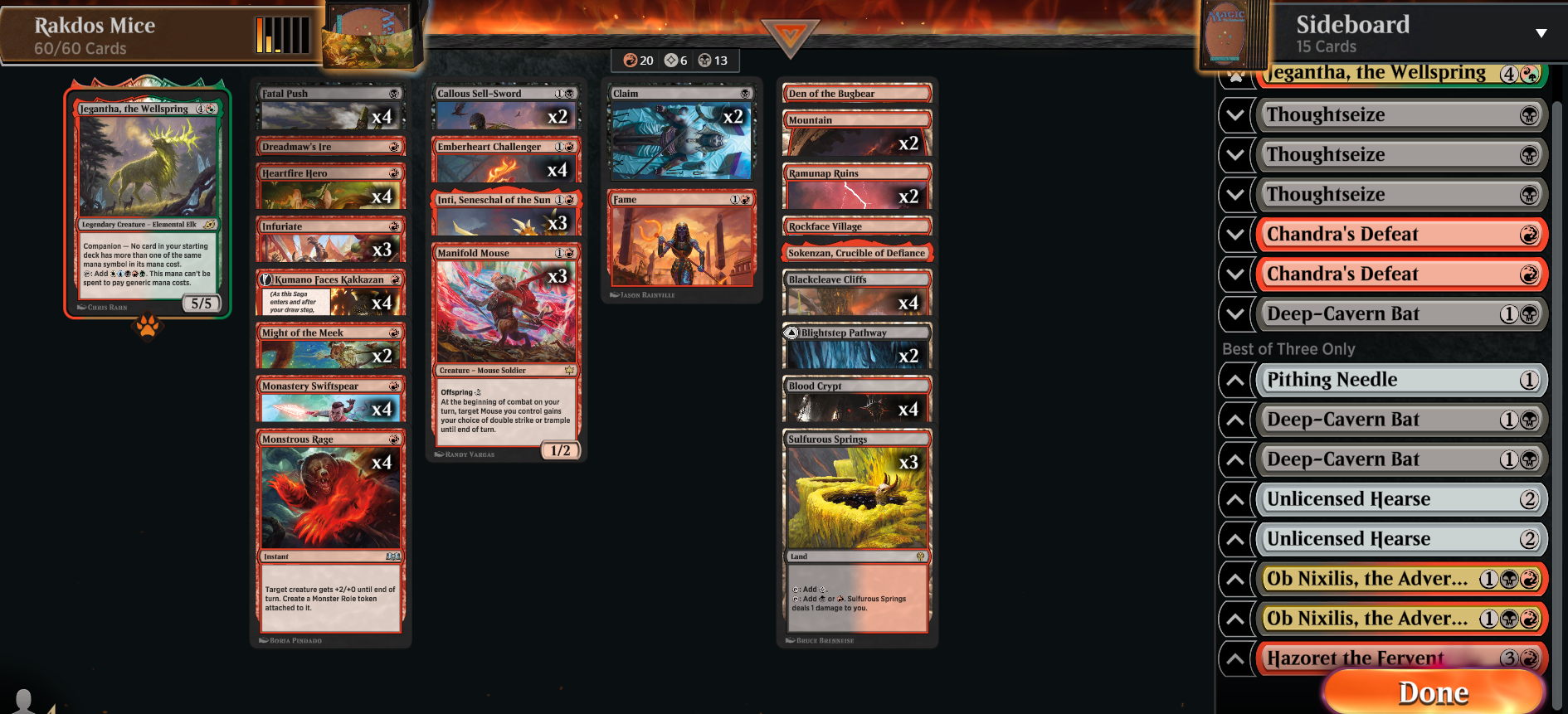
there's a two-week gap between the previous build and this one - a lot has changed
And as Hannah kept playing more with Manifold, the reports she had on it kept being extremely positive. It looked a bit goofy, leaning more into the Bloomburrow typal theme - but it was actually kind of working!
This, then, was one of the final pieces of the puzzle. How do we solve the problematic play-patterns around being forced to act too proactively with pump spells, without giving up too much explosivity? The answer is simple: play more mice!
Sidenote: there are many many many other iterations that we on Sanctum went through in exploring the red aggro space, including various levels of unhinged builds from Boros Mice to Rakdos Midrange With Flings. I've picked out the ones I most remember, and ones that seem most pertinent to our final build; but there were many many more besides.
Part 3: The Final List

So how did we get from these vague ideas, to our final numbers? Well, let's break things down a bit.
Infuriate
A perpetual question during testing was: "which pump spell is best?" We knew we wanted +3 power pump spells, and the options available (other than the mandatory 4 Monstrous Rage) were
Turn Inside Out, Titan's Strength, and Infuriate.Ultimately, we settled on Infuriates simply because we felt the toughness boost was extremely important vs blockers and red removal. We especially wanted to focus on the Phoenix matchup, and it turned out that the extra toughness actually quite often made a huge difference there.
Finally, we also all agreed that one miser's copy of
Dreadmaw's Ire was a good open decklist flex to make opponents sweat, as well as just a fine metagame tool vs Witch's Oven and Portable Hole.4/3/2/1
I only realized this after locking in my list, but this ended up being quite the aesthetic split of 2-drop creatures to play :P
4
Emberheart Challenger as our best 2 drop by far seemed obvious.3 Manifold Mice was nice as our next best 2 drop, but one that was worse to draw in multiples. We ended up deciding that this card was just the solution to all our problems - it very much helped with grinding against decks that tried to leverage reactivity to blow out combat tricks, played better into the
High Noon lists running around, and accomplished all of that without giving up much explosivity!The card ended up feeling absolutely amazing all day at the RC for me, even in the mirror where I would expect it to fall off a bit in effectiveness.
2 Slickshot was a concession to still wanting some amount of the traditional explosive draws of the stock Rakdos lists. After all, we're still playing 8 pump spells - it's nice to occasionally have a flier to wear those pump spells, without needing to commit to always supporting drawing them.
Finally, a single copy of Inti was just a nice 1-of for a bit of extra smoothing in order to support some of our more conditional interaction spells, while doubling up as more valiant triggers for our mice, and just a nice aggressive threat overall.
Mapping Out the Interaction Suite
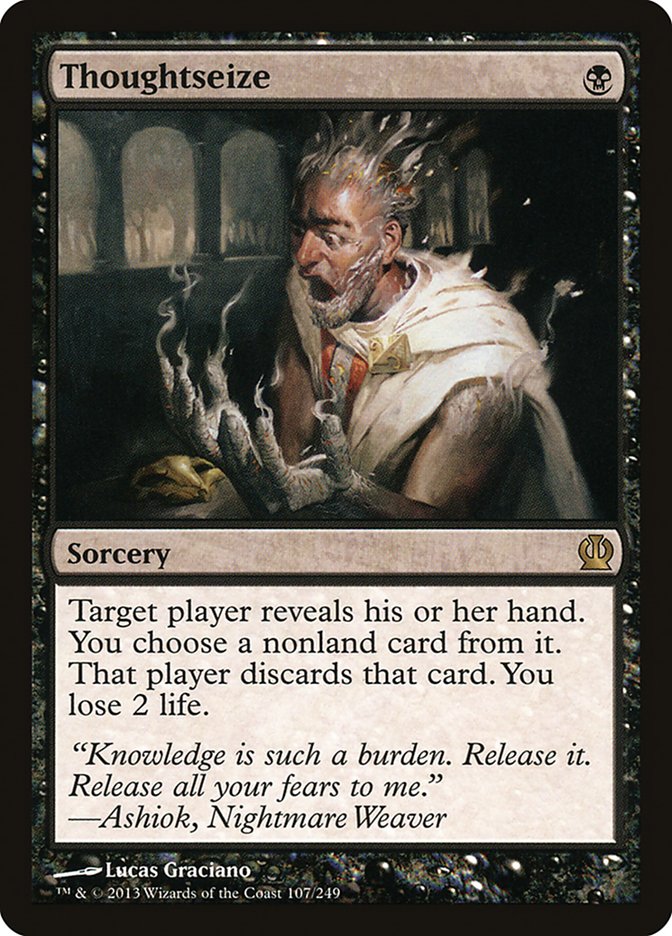
Pretty early on, we settled on wanting 4 copies of Fatal Push in the maindeck - we found it was the most important card both in the mirror and against Phoenix, so it felt like kind of a no-brainer.
But honestly, one of the developments I'm personally most proud of is the inclusion of 2 copies of Thoughtseize maindeck. This one has a great story behind it:
About a week before the RC, I started a very impromptu latenight voice call that ended up including quite a few of the Rakdos Mice crew. Specifically, I had two goals that night: do some preliminary sideboard mapping, and propose my latest brainworms of playing Thoughtseizes in the maindeck.
When I proposed this brainworm, it wasn't quite fully formed. My only reasoning was basically: "I think this card is just good in basically every matchup. Why don't we just maindeck a couple?" This, unsurprisingly, wasn't all that convincing. So, we proceeded to what I hoped would help my case: sideboard mapping.
By the end of the mapping session, after we had mapped out sideboard plans for all of the popular decks, I made my case again. And this time, I was both much more certain in my belief, and much more convincing. As it turns out, we had in fact basically sided in at least two thoughtseizes in almost every matchup; and we had also sided out two Might of the Meeks in almost every matchup!
And of course, it's possible to have situations where this can make sense - some cards are better preboard, while others can be better postboard. But when we were already struggling for sideboard space to fit everything we wanted, and when the mapping looked so clean if we just moved the Thoughtseizes main... the proposal looked quite appealing.
So we started trying it. And we quickly found it to be actually a really good innovation! As Sky first put it: one of the nicest parts is that Thoughtseize actually kind of falls into the "creature that triggers prowess" category, in a roundabout way. After all, quite often the card you take with it is a removal spell - so it's almost like you cast an additional creature while triggering prowess, except with much more upside and flexibility besides.
And nicely, my earlier work also held sound: cutting the two copies of Might of the Meek didn't feel structurally bad at all! We had kept them in as filler for somewhat historical reasons, but as it turns out they just weren't that necessary anymore with how we ended up building our deck.
Sideboard Mapping, and Conclusion
This is normally where I'd put a more detailed sideboard and matchup guide; however I don't think there are many interesting notes to include. The deck has quite a lot of play to it, but your fundamental play patterns often end up being similar from matchup to matchup. As such, I'll just leave you with a simple spreadsheet sideboard guide.
This isn't to say that the games are easy! To the contrary, creature-based aggro decks are quite often quite complex to play, and this one is certainly no different. Every game is a delicate balance of managing how much you want to risk to push more damage. Applying juuuuust enough pressure while still dancing around the opponent's potential interaction is a hard skill to master!
Overall, I'm extremely happy with our build of Mice. We had a wide range of records, but had quite a few team members getting 10-5 records at RC DC, including one - Joe Florman - qualifying for the PT for the first time by going 11-4!
And more importantly, the vibes were excellent. Throughout the day I felt extremely rewarded for every single deckbuilding decision we made - the highlight of my day was a UW opponent commenting during sideboarding: "Why is your deck so well built?? I don't know how to beat it!"
Even still, I do think Phoenix ended up being a better choice overall. And with a bit more time and focus, I think I could've done better at DC with Phoenix - but given my goals and constraints, I'm quite content with how we did with Mice. So if you want to play an aggro deck in Pioneer, I would recommend you start getting familiar with the manifold facets of mice.
#FreePalestine | Consider donating to UNWRA or PCRF, supporting protesters locally, and educating yourself.
